The Impact of Hypoglycemia on Patients with Diabetes Mellitus: A Cross-Sectional Analysis
Abstract
:1. Introduction
2. Materials and Methods
2.1. Study Design and Participants
2.2. Variables
2.3. Statistics
3. Results
4. Discussion
Supplementary Materials
Author Contributions
Funding
Institutional Review Board Statement
Informed Consent Statement
Data Availability Statement
Conflicts of Interest
References
- Lovic, D.; Piperidou, A.; Zografou, I.; Grassos, H.; Pittaras, A.; Manolis, A. The Growing Epidemic of Diabetes Mellitus. Curr. Vasc. Pharmacol. 2019, 18, 104–109. [Google Scholar] [CrossRef]
- American Diabetes Association. Classification and diagnosis of diabetes. Diabetes Care 2015, 38, S8–S16. [Google Scholar] [CrossRef] [Green Version]
- Lascar, N.; Brown, J.; Pattison, H.; Barnett, A.H.; Bailey, C.J.; Bellary, S. Type 2 diabetes in adolescents and young adults. Lancet Diabetes Endocrinol. 2018, 6, 69–80. [Google Scholar] [CrossRef] [Green Version]
- Zurita-Cruz, J.N.; Manuel-Apolinar, L.; Arellano-Flores, M.L.; Gutierrez-Gonzalez, A.; Najera-Ahumada, A.G.; Cisneros-González, N. Health and quality of life outcomes impairment of quality of life in type 2 diabetes mellitus: A cross-sectional study. Health Qual. Life Outcomes 2018, 16, 94. [Google Scholar] [CrossRef]
- Wermeling, P.R.; Gorter, K.J.; Van Stel, H.F.R.G. Both cardiovascular and noncardiovascular comorbidity are related to health status in well-controlled type 2 diabetes patients: A cross-sectional analysis. Cardiovasc. Diabetol. 2012, 11, 121. [Google Scholar] [CrossRef] [PubMed] [Green Version]
- Bannier, K.; Lichtenauer, M.; Franz, M.; Fritzenwanger, M.; Kabisch, B.; Figulla, H.R.; Pfeifer, R.; Jung, C. Impact of diabetes mellitus and its complications: Survival and quality-of-life in critically ill patients. J. Diabetes Complicat. 2015, 29, 1130–1135. [Google Scholar] [CrossRef]
- Roy, T.; Lloyd, C.E. Epidemiology of depression and diabetes: A systematic review. J. Affect Disord. 2012, 142, S8–S21. [Google Scholar] [CrossRef]
- Bădescu, S.V.; Tătaru, C.; Kobylinska, L.; Georgescu, E.L.; Zahiu, D.M.; Zăgrean, A.M.; Zăgrean, L. The association between Diabetes mellitus and Depression. J. Med. Life 2016, 9, 120–125. [Google Scholar] [PubMed]
- Iqbal, A.; Heller, S. Managing hypoglycaemia. Best Pract. Res. Clin. Endocrinol. Metab. 2016, 30, 413–430. [Google Scholar] [CrossRef] [Green Version]
- Cryer, P.E. Defining and reporting hypoglycemia in diabetes: A report from the American diabetes association workgroup on hypoglycemia. Diabetes Care 2005, 28, 1245–1249. [Google Scholar] [CrossRef] [Green Version]
- Cryer, P.E.; Davis, S.N.; Shamoon, H. Hypoglycemia in diabetes. Diabetes Care 2003, 26, 1902–1912. [Google Scholar] [CrossRef] [Green Version]
- Snell-Bergeon, J.K.; Wadwa, R.P. Hypoglycemia, diabetes, and cardiovascular disease. Diabetes Technol. Ther. 2012, 14 (Suppl. 1), S51–S58. [Google Scholar] [CrossRef] [PubMed] [Green Version]
- Leon, B.M.; Maddox, T.M. Diabetes and cardiovascular disease: Epidemiology, biological mechanisms, treatment recommendations and future research. World J. Diabetes 2015, 6, 1246–1258. [Google Scholar] [CrossRef] [PubMed]
- Amiel, S.A.; Aschner, P.; Childs, B.; Cryer, P.E.; de Galan, B.E.; Frier, B.M.; Gonder-Frederick, L.; Heller, S.R.; Jones, T.; Khunti, K.; et al. Hypoglycaemia, cardiovascular disease, and mortality in diabetes: Epidemiology, pathogenesis, and management. Lancet Diabetes Endocrinol. 2019, 7, 385–396. [Google Scholar] [CrossRef]
- Bakatselos, S.O. Hypoglycemia unawareness. Diabetes Res. Clin. Pract. 2011, 93, S92–S96. [Google Scholar] [CrossRef]
- Zammitt, N.N.; Streftaris, G.; Gibson, G.J.; Deary, I.J.; Frier, B.M. Modeling the consistency of hypoglycemic symptoms: High variability in diabetes. Diabetes Technol. Ther. 2011, 13, 571–578. [Google Scholar] [CrossRef] [PubMed] [Green Version]
- Diedrich, L.; Sandoval, D.; Davis, S.N. Hypoglycemia associated autonomic failure. Clin. Auton. Res. 2002, 12, 358–365. [Google Scholar] [CrossRef] [PubMed]
- Zammitt, N.N.; Frier, B.M. Hypoglycemia in type 2 diabetes: Pathophysiology, frequency, and effects of different treatment modalities. Diabetes Care 2005, 28, 2948–2961. [Google Scholar] [CrossRef] [Green Version]
- McAulay, V.; Deary, I.J.; Frier, B.M. Symptoms of hypoglycaemia in people with diabetes. Diabet. Med. 2001, 18, 690–705. [Google Scholar] [CrossRef]
- Cryer, P.E. Diverse Causes of Hypoglycemia-Associated Autonomic Failure in Diabetes. N. Engl. J. Med. 2004, 350, 2272–2279. [Google Scholar] [CrossRef] [PubMed] [Green Version]
- Cryer, P.E. Hypoglycemia risk reduction in type 1 diabetes. Exp. Clin. Endocrinol. Diabetes 2001, 109, S412–S423. [Google Scholar] [CrossRef] [PubMed]
- Stanford Patient Education Research Center, Stanford University School of Medicine. Diabetes: Sample Questionnaire; Stanford Patient Education Research Center, Stanford University School of Medicine: Stanford, CA, USA, 2012. [Google Scholar]
- DHHS. National Diabetes Statistics Report 2020; Centers for Disease Control and Prevention: Atlanta, GA, USA, 2020; Volume 2. [Google Scholar]
- Cryer, P.E. Hypoglycemia: Still the limiting factor in the glycemic management of diabetes. Endocr. Pract. 2008, 14, 750–756. [Google Scholar] [CrossRef] [PubMed]
- Zoungas, S.; Patel, A.; Chalmers, J.; de Galan, B.E.; Li, Q.; Billot, L.; Woodward, M.; Ninomiya, T.; Neal, B.; MacMahon, S.; et al. Severe Hypoglycemia and Risks of Vascular Events and Death. N. Engl. J. Med. 2010, 363, 1410–1418. [Google Scholar] [CrossRef] [PubMed] [Green Version]
- Cryer, P. Hypoglycemia in Diabetes: Pathophysiology, Prevalence, and Prevention; American Diabetes Association: Alexandria, VA, USA, 2016. [Google Scholar]
- Alsahli, M.; Gerich, J.E. Hypoglycemia in patients with diabetes and renal disease. J. Clin. Med. 2015, 4, 948–964. [Google Scholar] [CrossRef] [PubMed]
- Goto, A.; Arah, O.A.; Goto, M.; Terauchi, Y.; Noda, M. Severe hypoglycaemia and cardiovascular disease: Systematic review and meta-analysis with bias analysis. BMJ 2013, 347, f4533. [Google Scholar] [CrossRef] [Green Version]
- Martín-Timón, I.; Del Cañizo-Gómez, F.J. Mechanisms of hypoglycemia unawareness and implications in diabetic patients. World J. Diabetes 2015, 6, 912–926. [Google Scholar] [CrossRef]
- Schopman, J.E.; Geddes, J.; Frier, B.M. Prevalence of impaired awareness of hypoglycaemia and frequency of hypoglycaemia in insulin-treated type 2 diabetes. Diabetes Res. Clin. Pract. 2010, 87, 64–68. [Google Scholar] [CrossRef]
- Yun, J.S.; Park, Y.M.; Han, K.; Cha, S.A.; Ahn, Y.B.; Ko, S.H. Association between BMI and risk of severe hypoglycaemia in type 2 diabetes. Diabetes Metab. 2019, 45, 19–25. [Google Scholar] [CrossRef]
- Tsai, T.-C.; Lee, C.-H.; Cheng, B.-C.; Kung, C.-T.; Chen, F.-C.; Shen, F.-C.; Lee, J.; Chen, Y.-C. Body Mass Index–Mortality Relationship in Severe Hypoglycemic Patients with Type 2 Diabetes. Am. J. Med. Sci. 2015, 349, 192–198. [Google Scholar] [CrossRef] [Green Version]
- Norman, K.; Pichard, C.; Lochs, H.; Pirlich, M. Prognostic impact of disease-related malnutrition. Clin. Nutr. 2008, 27, 5–15. [Google Scholar] [CrossRef] [PubMed]
- Statista. How Much Time on Average Do You Spend on Your Phone on a Daily Basis? 2021. Available online: https://www.statista.com/statistics/1224510/time-spent-per-day-on-smartphone-us/ (accessed on 27 July 2021).
- Throuvala, M.A.; Griffiths, M.D.; Rennoldson, M.; Kuss, D.J. The Role of Recreational Online Activities in School-Based Screen Time Sedentary Behaviour Interventions for Adolescents: A Systematic and Critical Literature Review. Int. J. Ment. Health Addict. 2021, 19, 1065–1115. [Google Scholar] [CrossRef] [Green Version]
- Grøntved, A.; Hu, F.B. Television viewing and risk of type 2 diabetes, cardiovascular disease, and all-cause mortality: A meta-analysis. JAMA 2011, 305, 2448–2455. [Google Scholar] [CrossRef] [PubMed] [Green Version]
- World Health Organization. Obesity and Overweight; WHO: Geneva, Switzerland, 2021. [Google Scholar]
- Adu, M.D.; Malabu, U.H.; Malau-Aduli, A.E.O.; Malau-Aduli, B.S. Enablers and barriers to effective diabetes self-management: A multi-national investigation. PLoS ONE 2019, 14, e0217771. [Google Scholar] [CrossRef] [PubMed] [Green Version]
- Jensen, M.H.; Cichosz, S.L.; Hirsch, I.B.; Vestergaard, P.; Hejlesen, O.; Seto, E. Smoking is Associated with Increased Risk of Not Achieving Glycemic Target, Increased Glycemic Variability, and Increased Risk of Hypoglycemia for People With Type 1 Diabetes. J. Diabetes Sci. Technol. 2020, 15, 827–832. [Google Scholar] [CrossRef] [PubMed]
- Van de Wiel, A. Diabetes mellitus ad alchohol. Diabetes. Metab. Res. Rev. 2004, 20, 263–267. [Google Scholar] [CrossRef]
- Chang, S.A. Smoking and type 2 diabetes mellitus. Diabetes Metab. J. 2012, 36, 399–403. [Google Scholar] [CrossRef] [Green Version]
- Will, J.C.; Galuska, D.A.; Ford, E.S.; Mokdad, A.; Calle, E.E. Cigarette smoking and diabetes mellitus: Evidence of a positive association from a large prospective cohort study. Int. J. Epidemiol. 2001, 30, 540–546. [Google Scholar] [CrossRef] [Green Version]
- Sherman, J.J. The Impact of Smoking and Quitting Smoking on Patients with Diabetes. Diabetes Spectr. 2005, 18, 202–208. [Google Scholar] [CrossRef] [Green Version]
- Whalen, K.L.; Stewart, R.D. Pharmacologic management of hypertension in patients with diabetes. Am. Fam. Physician 2008, 78, 1277–1282. [Google Scholar]
- Severino, P.; D’Amato, A.; Netti, L.; Pucci, M.; De Marchis, M.; Palmirotta, R.; Volterrani, M.; Mancone, M.; Fedele, F. Diabetes Mellitus and Ischemic Heart Disease: The Role of Ion Channels. Int. J. Mol. Sci. 2018, 19, 802. [Google Scholar] [CrossRef] [Green Version]
- Duan, J.; Zheng, C.; Gao, K.; Hao, M.; Yang, L.; Guo, D.; Wu, J.; Tian, Y.; Song, X.; Liu, J.; et al. Ultrasonography of lower limb vascular angiopathy and plaque formation in type 2 diabetes patients and finding its relevance to the carotid atherosclerotic formation. Pak. J. Med. Sci. 2014, 30, 54–58. [Google Scholar]
- Nelson, R.H. Hyperlipidemia as a risk factor for cardiovascular disease. Prim. Care. 2013, 40, 195–211. [Google Scholar] [CrossRef] [Green Version]
- Idzior-Waluś, B.; Waluś-Miarka, M. Leczenie dyslipidemii u chorych na cukrzycę—Indywidualizacja strategii ter peutycznych. Treatment of dyslipidemia in diabetes—Individualization of therapeutic strategies. Diabetol. Klin. 2013, 2, 23–29. [Google Scholar]
- Ensling, M.; Steinmann, W.; Whaley-Connell, A. Hypoglycemia: A Possible Link between Insulin Resistance, Metabolic Dyslipidemia, and Heart and Kidney Disease (the Cardiorenal Syndrome). Cardioren. Med. 2011, 1, 67–74. [Google Scholar] [CrossRef] [Green Version]
- Jingi, A.M.; Tankeu, A.T.; Ateba, N.A.; Noubiap, J.J. Mechanism of worsening diabetic retinopathy with rapid lowering of blood glucose: The synergistic hypothesis. BMC Endocr. Disord. 2017, 17, 63. [Google Scholar] [CrossRef] [Green Version]
- Wierzchowiecka, A.; Zozulińska-Ziółkiewicz, D. Hipoglikemia w cukrzycy typu 1. Hypoglycaemia in type 1 diabetes. Diabetol. Prakt. 2011, 12, 210–215. [Google Scholar]
- Ehrlich, S.F.; Quesenberry, C.P., Jr.; Van Den Eeden, S.K.; Shan, J.; Ferrara, A. Patients diagnosed with diabetes are at increased risk for asthma, chronic obstructive pulmonary disease, pulmonary fibrosis, and pneumonia but not lung cancer. Diabetes Care 2010, 33, 55–60. [Google Scholar] [CrossRef] [Green Version]
- Weir, D.C.; Jennings, P.E.; Hendy, M.S.; Barnett, A.H.; Burge, P.S. Transfer factor for carbon monoxide in patients with diabetes with and without microangiopathy. Thorax 1988, 43, 725–726. [Google Scholar] [CrossRef] [Green Version]
- Russell, K.S.; Stevens, J.R.; Stern, T.A. Insulin overdose among patients with diabetes: A readily available means of suicide. Prim. Care Companion J. Clin. Psychiatry 2009, 11, 258–262. [Google Scholar] [CrossRef] [PubMed] [Green Version]
- Von Mach, M.A.; Meyer, S.; Omogbehin, B.; Kann, P.H.; Weilemann, L.S. Epidemiological assessment of 160 cases of insulin overdose recorded in a regional poisons unit. Int. J. Clin. Pharmacol. Ther. 2004, 42, 277–280. [Google Scholar] [CrossRef] [PubMed]
- Gibbons, C.H.; Adler, G.K.; Bonyhay, I.; Freeman, R. Experimental hypoglycemia is a human model of stress-induced hyperalgesia. Pain 2012, 153, 2204–2209. [Google Scholar] [CrossRef] [PubMed]
- Kahal, H.; Halama, A.; Aburima, A.; Bhagwat, A.M.; Butler, A.E.; Graumann, J.; Sugre, K.; Sathyapalan, T.; Atkin, S.L. Effect of induced hypoglycemia on inflammation and oxidative stress in type 2 diabetes and control subjects. Sci. Rep. 2020, 10, 4750. [Google Scholar] [CrossRef] [PubMed] [Green Version]
- Powers, M.A.; Bardsley, J.; Cypress, M.; Duker, P.; Funnell, M.M.; Fischl, A.H.; Maryniuk, M.D.; Siminerio, L.; Vivian, E. Diabetes self-management education and support in type 2 diabetes: A joint position statement of the American Diabetes Association, the American Association of Diabetes Educators, and the Academy of Nutrition and Dietetics. Diabetes Care 2015, 38, 1372–1382. [Google Scholar] [CrossRef] [PubMed] [Green Version]
- Pillay, J.; Armstrong, M.J.; Butalia, S.; Donovan, L.E.; Sigal, R.J.; Chordiya, P.; Dhakal, S.; Vandermeer, B.; Hartling, L.; Nuspl, M.; et al. Behavioral programs for type 1 diabetes mellitus: A systematic review and meta-analysis. Ann. Intern. Med. 2015, 163, 836–847. [Google Scholar] [CrossRef] [PubMed] [Green Version]
- Ismail, K.; Winkley, K.; Rabe-Hesketh, S. Systematic review and meta-analysis of randomised controlled trials of psychological interventions to improve glycaemic control in patients with type 2 diabetes. Lancet 2004, 363, 1589–1597. [Google Scholar] [CrossRef]
- DAFNE Study Group. Training in flexible, intensive insulin management to enable dietary freedom in people with type 1 diabetes: Dose adjustment for normal eating (DAFNE) randomised controlled trial. BMJ 2002, 325, 746. [Google Scholar] [CrossRef] [Green Version]
- Deakin, T.A.; Cade, J.E.; Williams, R.; Greenwood, D.C. Structured patienteducation: The diabetes X-PERT programme makes a difference. Diabet. Med. 2006, 23, 944–954. [Google Scholar] [CrossRef] [Green Version]
- Ko, S.-H.; Song, K.-H.; Kim, S.-R.; Lee, J.-M.; Kim, J.-S.; Shin, J.-H.; Cho, Y.-K.; Park, Y.-M.; Jeong, J.-H.; Yoon, K.-H.; et al. Long-Term effects of a structured intensive diabetes education programme (SIDEP) in patients with Type 2 diabetes mellitus—A 4-year follow-up study. Diabetic Med. 2007, 24, 55–62. [Google Scholar] [CrossRef]
- Trento, M.; Gamba, S.; Gentile, L.; Grassi, G.; Miselli, V.; Morone, G.; Passera, P.; Tonutti, L.; Tomalino, M.; Bondonio, P.; et al. Rethink Organization to Improve Education and Outcomes (ROMEO): A multicenter randomized trial of lifestyle intervention by group care to manage type 2 diabetes. Diabetes Care 2010, 33, 745–747. [Google Scholar] [CrossRef] [Green Version]
- Adolfsson, E.T.; Walker-Engström, M.L.; Smide, B.; Wikblad, K. Patient education in type 2 diabetes: A randomized controlled 1-year follow-up study. Diabetes Res. Clin. Pract. 2007, 76, 341–350. [Google Scholar] [CrossRef]
- Pieber, T.R.; Brunner, G.A.; Schnedl, W.J.; Schattenberg, S.; Kaufmann, P.; Krejs, G.J. Evaluation of a structured outpatient group education program for intensive insulin therapy. Diabetes Care 1995, 18, 625–630. [Google Scholar] [CrossRef] [PubMed]
- Sämann, A.; Mühlhauser, I.; Bender, R.; Kloos, C.; Müller, U.A. Glycaemic control and severe hypoglycaemia following training in flexible, intensive insulin therapy to enable dietary freedom in people with type 1 diabetes: A prospective implementation study. Diabetologia 2005, 48, 1965–1970. [Google Scholar] [CrossRef] [PubMed] [Green Version]
- Bendik, C.F.; Keller, U.; Moriconi, N.; Gessler, A.; Schindler, C.; Zulewski, H.; Ruiz, J.; Puder, J.J. Training in flexible intensive insulin therapy improves quality of life, decreases the risk of hypoglycaemia and ameliorates poor metabolic control in patients with type 1 diabetes. Diabetes Res. Clin. Pract. 2009, 83, 327–333. [Google Scholar] [CrossRef] [PubMed]
- Lemozy-Cadroy, S.; Crognier, S.; Gourdy, P.; Chauchard, M.C.; Chale, J.P.; Dagger, J.P.T.; Hanaire-Broutin, H. Intensified treatment of type 1 diabetes: Prospective evaluation at one year of a therapeutic patient education programme. Diabetes Metab. 2002, 28, 287–294. [Google Scholar] [PubMed]
- Education in Diabetes. Available online: http://www.pfed.org.pl/uploads/1/9/9/8/19983953/diab_eng_web_2016_01_07.pdf (accessed on 6 December 2021).
- Samodzielny Zespół Publicznych Zakładów Lecznictwa Otwartego Warszawa Praga-Północ. Available online: https://www.szpzlo.pl/strona-129-program_stop_cukrzycy_na_lata_2020_2022.html (accessed on 6 December 2021).
- Regionalny Program Zdrowotny Samorządu Województwa Mazowieckiego. Available online: https://www.funduszedlamazowsza.eu/wp-content/uploads/2017/12/13-zalacznik-nr-11-regionalny-program-zdrowotny-pdf-.pdf (accessed on 6 December 2021).
- Gilis-Januszewska, A.; Lindström, J.; Tuomilehto, J.; Piwońska-Solska, B.; Topór-Mądry, R.; Szybiński, Z.; Peltonen, M.; Schwarz, P.E.; Windak, A.; Hubalewska-Dydejczyk, A. Sustained diabetes risk reduction after real life and primary health care setting implementation of the diabetes in Europe prevention using lifestyle, physical activity and nutritional intervention (DE-PLAN) project. BMC Public Health 2017, 17, 198. [Google Scholar] [CrossRef]
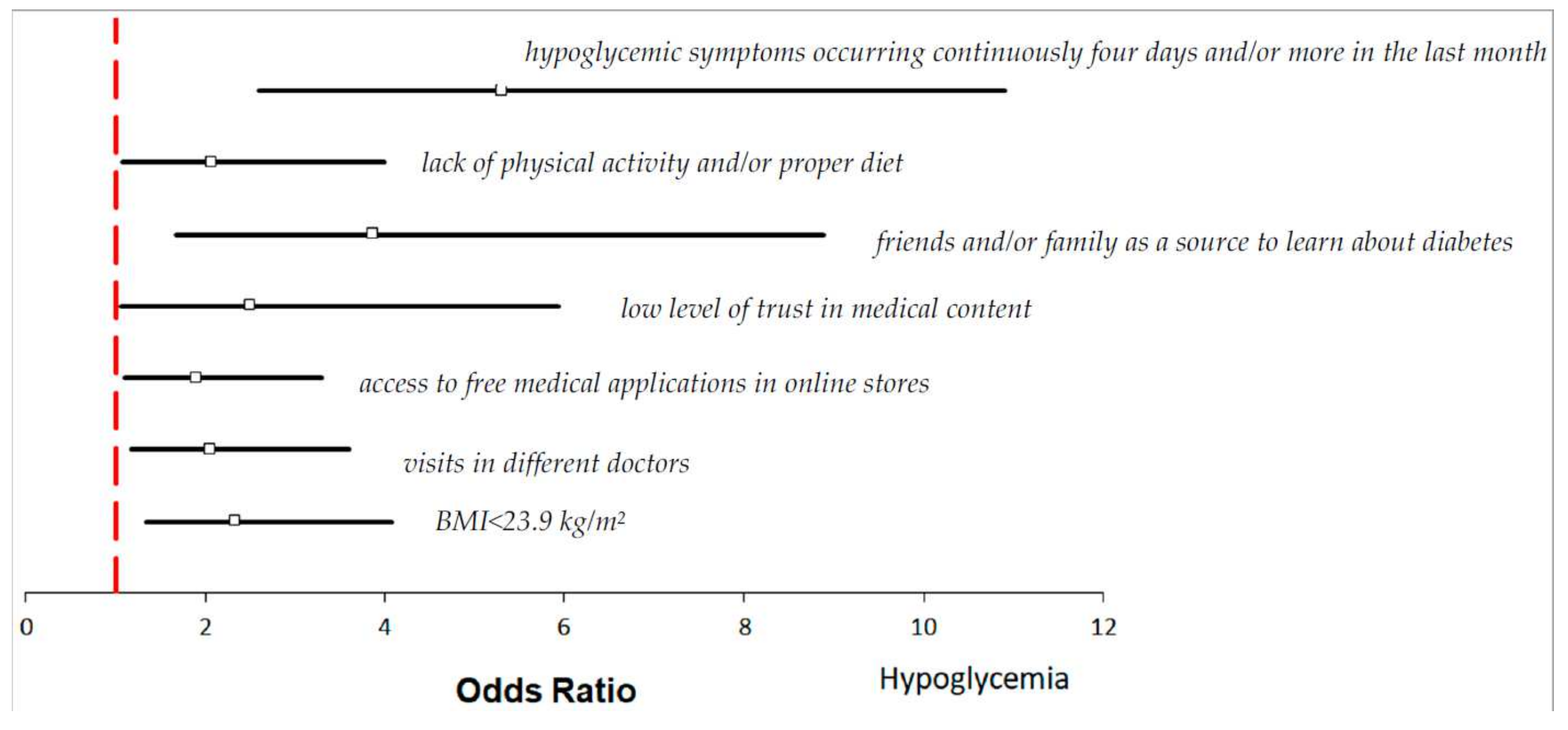
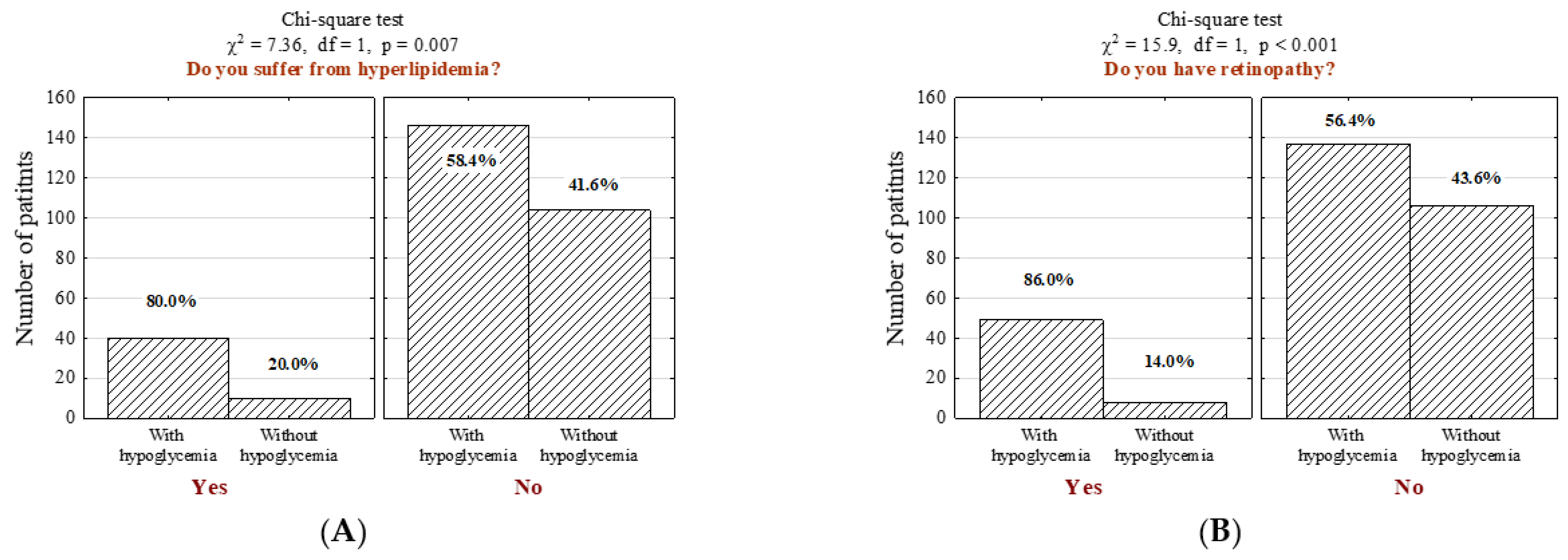

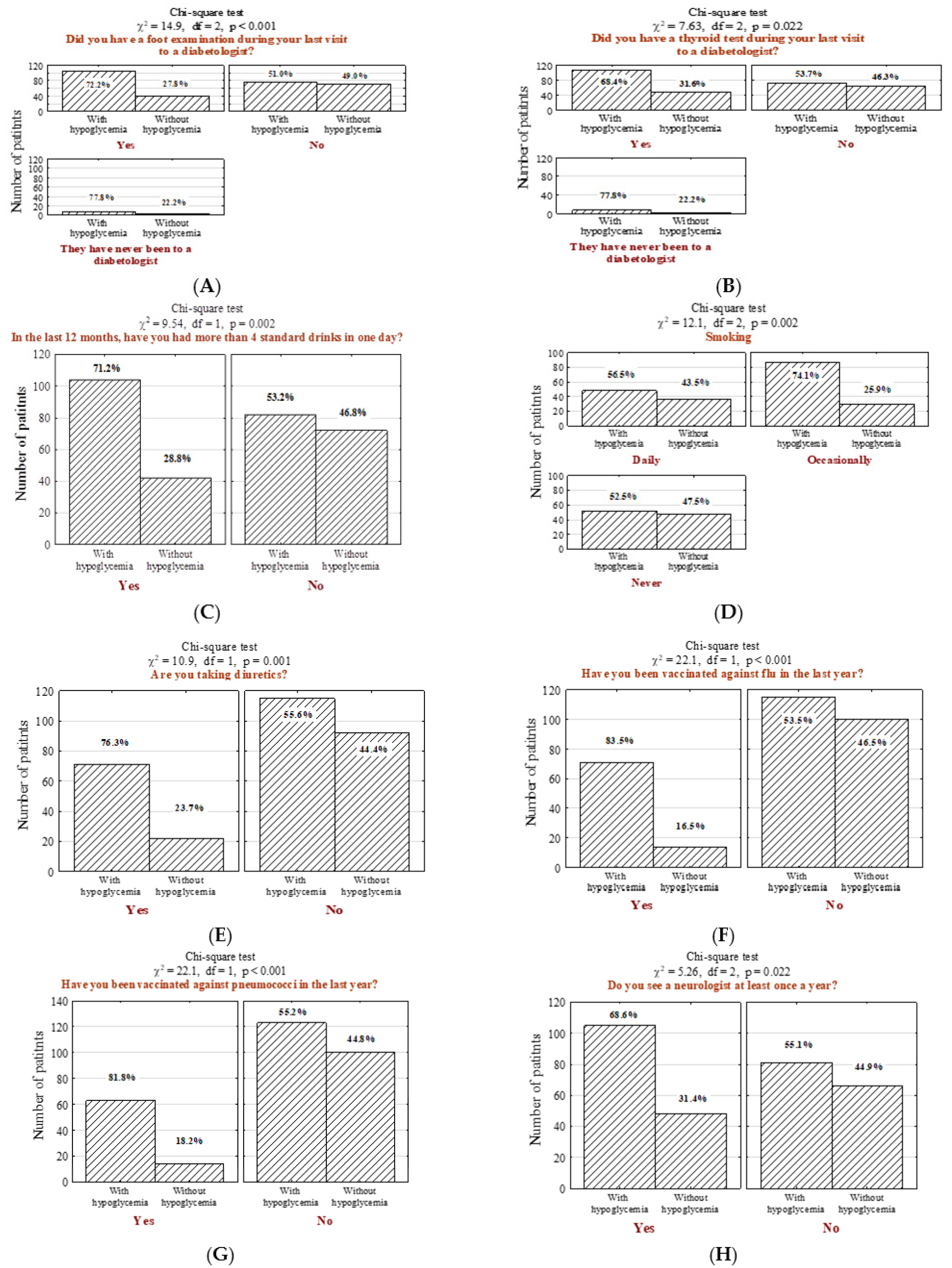
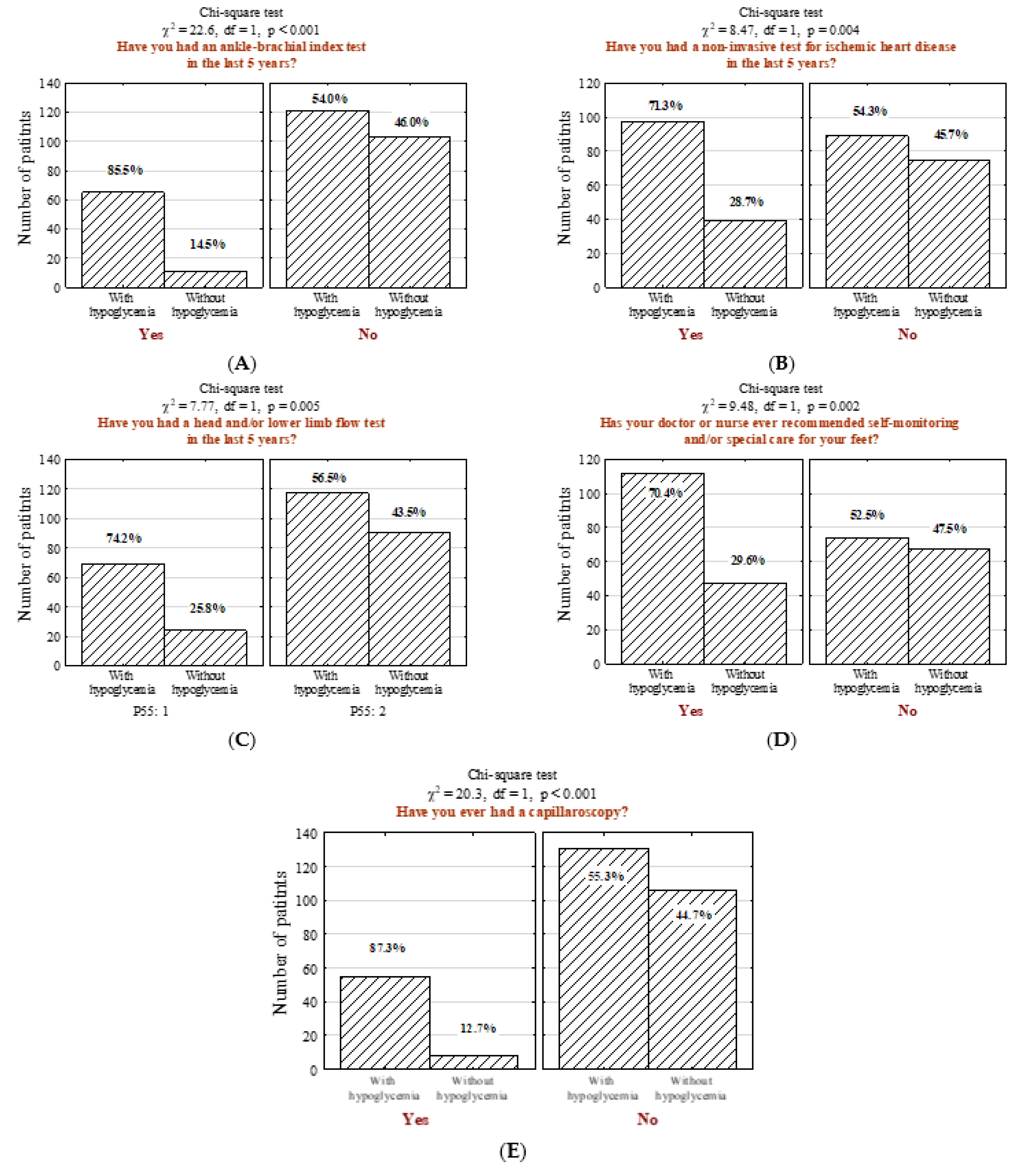
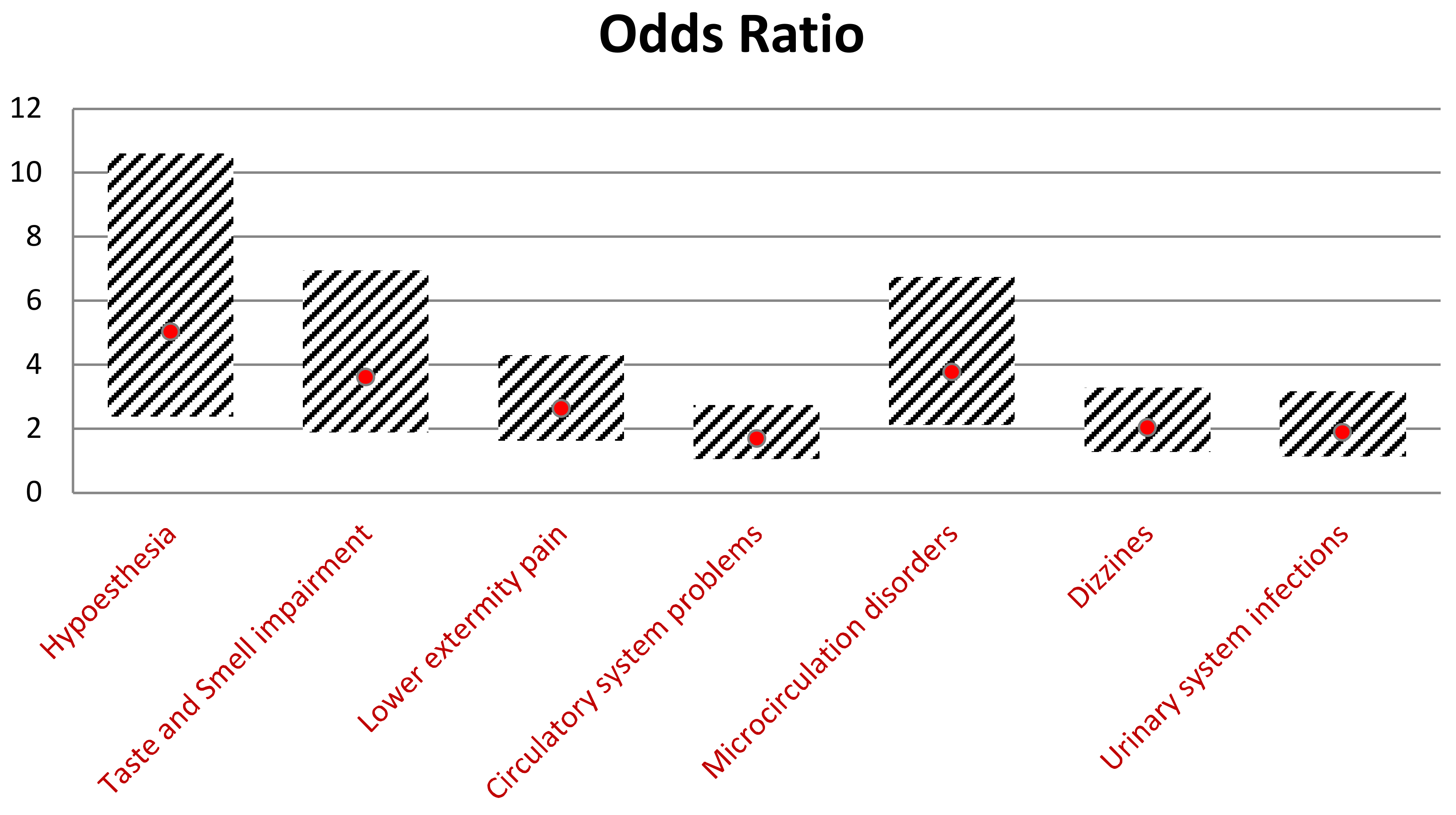
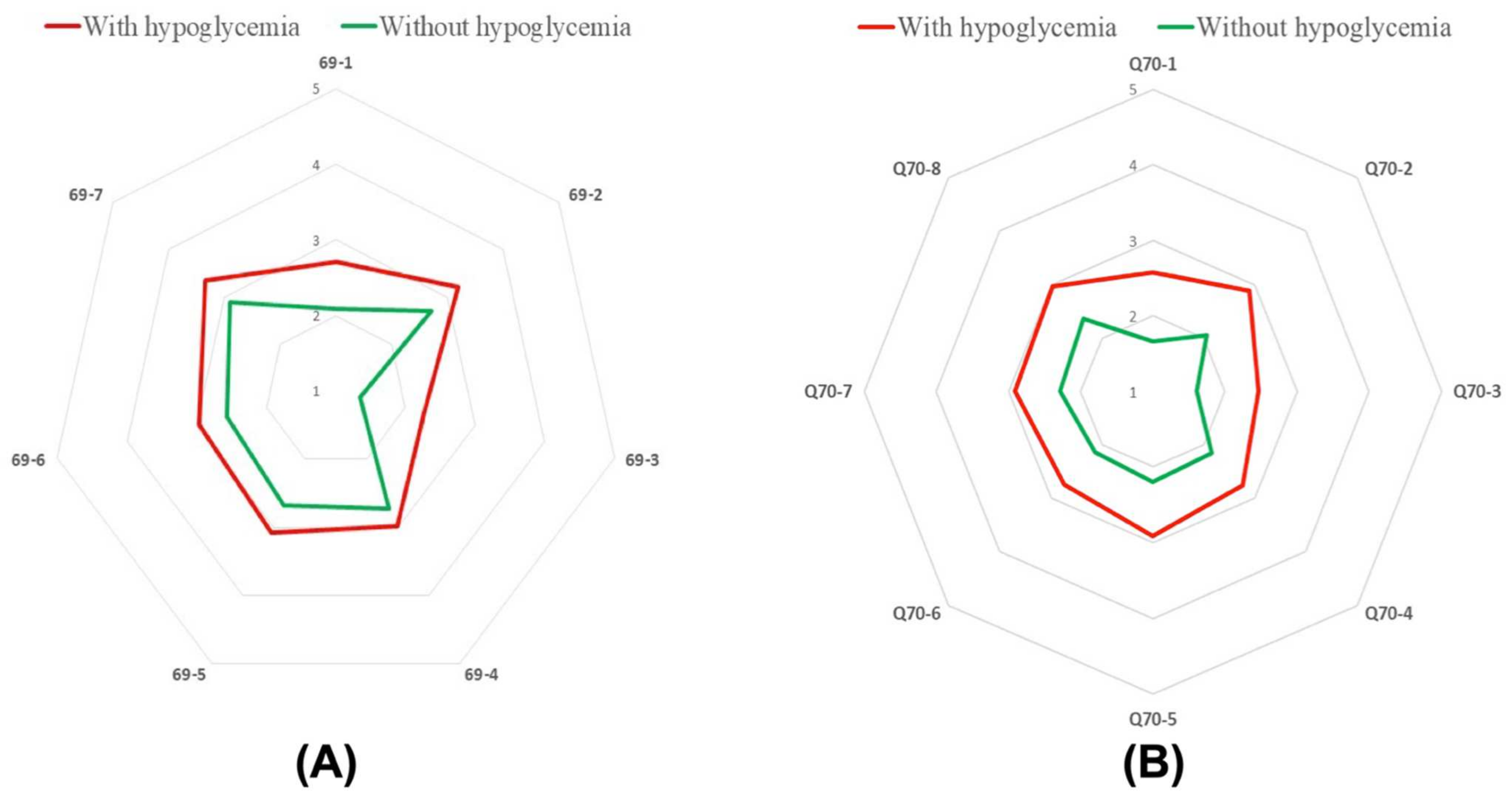
Publisher’s Note: MDPI stays neutral with regard to jurisdictional claims in published maps and institutional affiliations. |
© 2022 by the authors. Licensee MDPI, Basel, Switzerland. This article is an open access article distributed under the terms and conditions of the Creative Commons Attribution (CC BY) license (https://creativecommons.org/licenses/by/4.0/).
Share and Cite
Agrawal, S.; Makuch, S.; Dróżdż, M.; Dudzik, T.; Domański, I.; Poręba, R.; Mazur, G. The Impact of Hypoglycemia on Patients with Diabetes Mellitus: A Cross-Sectional Analysis. J. Clin. Med. 2022, 11, 626. https://doi.org/10.3390/jcm11030626
Agrawal S, Makuch S, Dróżdż M, Dudzik T, Domański I, Poręba R, Mazur G. The Impact of Hypoglycemia on Patients with Diabetes Mellitus: A Cross-Sectional Analysis. Journal of Clinical Medicine. 2022; 11(3):626. https://doi.org/10.3390/jcm11030626
Chicago/Turabian StyleAgrawal, Siddarth, Sebastian Makuch, Mateusz Dróżdż, Tomasz Dudzik, Igor Domański, Rafał Poręba, and Grzegorz Mazur. 2022. "The Impact of Hypoglycemia on Patients with Diabetes Mellitus: A Cross-Sectional Analysis" Journal of Clinical Medicine 11, no. 3: 626. https://doi.org/10.3390/jcm11030626
APA StyleAgrawal, S., Makuch, S., Dróżdż, M., Dudzik, T., Domański, I., Poręba, R., & Mazur, G. (2022). The Impact of Hypoglycemia on Patients with Diabetes Mellitus: A Cross-Sectional Analysis. Journal of Clinical Medicine, 11(3), 626. https://doi.org/10.3390/jcm11030626





